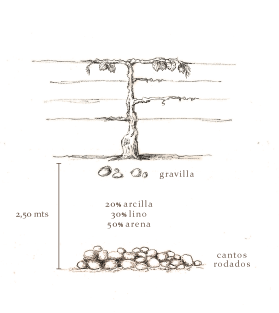





Our vineyards are located in Lunlunta, department of Maipú, in Mendoza province, Argentina at 33° South Latitude. The wine tradition of the region dates back to 1569, when the first vine plantations were made in Mendoza. Today 80% of all Argentine wine is produced in Mendoza, which makes it the eight in the world wide production.
Our estate in Lunlunta, located on the north bank of Mendoza River at 2,821 feet above sea level, has belonged to Mosso family since 1932. Due to the proximity to the river bank, the soil is alluvial, formed by sediments brought by the waters from the Andes, being of loam-silty to sandy texture. The gravel and stones below the surface confer to the soil´s excellent drainage, with a deepness of approx 80 cm. These conditions, combined with the soil´s porous nature favors the health of the vine´s roots. The soil is young and poor in organic material, which naturally restricts plant growth, resulting in an exceptional fruit, with authentic flavors and aromas, concentrated and intense.

The continental weather is mild and dry, with a wide thermal amplitude between day and night; in Mendoza there are 300 sunny days a year. Due to the lack of rain (180mm average a year), the inhabitants of the area have been forced to use an irrigation system that dates back from pre-Colombian times to water the crops. The snow accumulated in the Andes mountains during the winter starts to melt in spring. This water, which is of exceptional purity, is conducted through an intricate system of ditches and canals of different sizes to every corner of the province to irrigate vines and other crops. Water shortage, while once was an obstacle has become an advantage because our plants only get water when necessary, and with a frequency optimal for grape development.
The natural lack of unwanted moisture and the dry climate of Mendoza means it is difficult (and at times impossible) for the development of fungus, bacteria and other pests, which makes use of fungicides and pesticides unnecessary. A quasi-organic production.
This particular combination of poor soils, dry climate, and man-managed irrigation creates ideal condition for growing grapes, it is here where Malbec of Famiglia Mosso grows
Malbec arrived in Argentina from the Southeast of France, brought by Michel Pouget around 1860; the varietal adapted extremely well to the conditions of this country to the point that today, Argentina is renowned for producing the finest Malbecs - and the ones grown in Mendoza are considered the best in the world.
The Mosso Malbec of Lunlunta has a typical deep ruby red color, with violet hues very characteristic of the varietal. Red fruit aromas are accompanied by sweet and round tannins, which produces fleshy and complex texture in the mouth, the fruit is balanced with the touches of oak that lead to an elegant and lingering finish.
